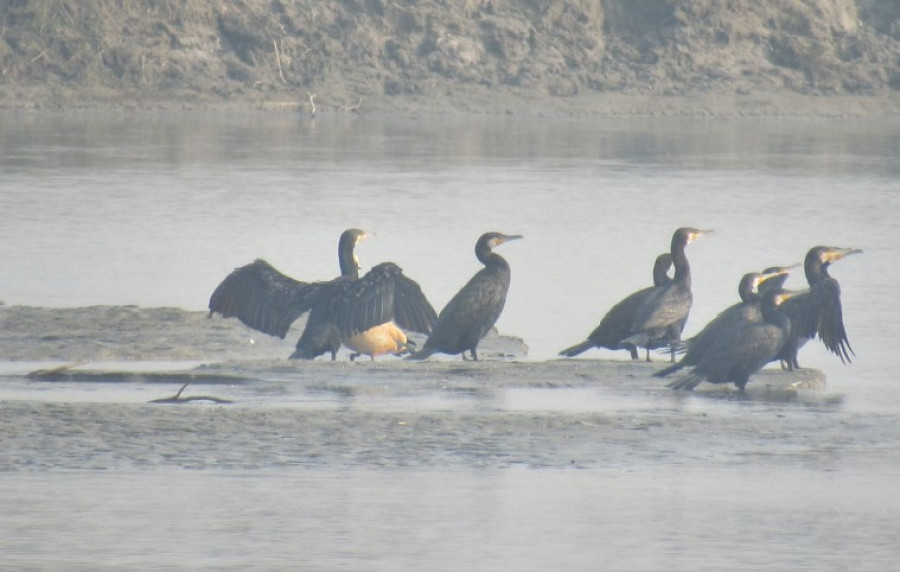Climate & Environment
Bird decline in Koshi Tappu alarms conservationists
A mid-winter census conducted recently shows decline in both bird species and population in the Koshi Tappu Wildlife Reserve and its vicinity.
Binod Bhandari
Conservationists are worried about the decline of aquatic bird population in the Koshi Tappu Wildlife Reserve and its vicinity, a major habitat of winter migratory birds in the country, this year.
A mid-winter bird census conducted a few weeks ago showed the decline in both bird species and bird population in Koshi Tappu Wildlife Reserve, the Koshi river and its surrounding areas. A total of 5,527 birds of 53 aquatic species have been recorded during the census.
Birding enthusiasts and ornithologists express their concerns as the country’s major destination of birding tourism witnesses declining aquatic bird population for the third consecutive year. As per the record available at the Koshi Tappu Wildlife Reserve, 56 bird species and a total 7,573 birds were recorded in 2023. The bird population was 7,664 in 2022.
“Some news species of aquatic birds used to be recorded almost every year during the bird census in Koshi Tappu Wildlife Reserve and its surrounding areas. But that did not happen this year. Compared to last year, there has been a decrease in three species of water birds, while more than 2,000 numbers of birds have been recorded in Koshi Tappu area this year,” said Birendra Gautam, chief at Koshi Conservation Centre of the National Trust for Nature Conservation. “The gradual decline of the aquatic bird population is worrisome.”
Every winter, birds migrate to several wetland areas of Nepal from Siberia, China, Mongolia, Turkmenistan, Kyrgyzstan among other countries and stay here until February. Bar-headed goose, greater and lesser adjutant and falcated duck, among others, are found in Koshi Tappu Wildlife Reserve. The Koshi river, Nandan pond, Indian camp pond and Kamaldaha pond are the major places for bird watching in the Koshi Tappu reserve.
Conservationists and other stakeholders suspect that loss of habitat, mainly due to human encroachment, haphazard extraction of riverbed materials, use of insecticides and pesticides in agricultural fields, excessive fishing and hunting are the major challenges to bird conservation in Nepal.
“Obstruction of high tension lines along the birds’ flight path and emergence of new habitats along their route could also be the reason behind the decreasing bird population in the Koshi Tappu Wildlife Reserve. The reserve spanning across Sunsari, Saptari and Udayapur districts is like the capital of birds. The alarming decline in bird population here is concerning,” said Gautam.
Koshi Tappu Wildlife Reserve, established in 1976, was declared a Ramsar site in 1987. Around 441 species of birds, according to the Department of National Parks and Wildlife Conservation, are found in Koshi Tappu Wildlife Reserve, which spreads across 176 square kilometers in the eastern Tarai.
During this year’s bird count, as many as 848 Lesser Whistling-ducks, locally called Silsile hans, were recorded in Koshi Tappu areas. Similarly, 506 Ruddy Shelducks, 455 Red-wattled Lapwings and 445 Great Cormorants were sighted.
Chakra Timsina, chairman of the Koshi Bird Society, underscores the need for the conservation of wetland areas to check the dwindling aquatic bird population in Nepal. He argued that lack of food is the leading reason behind the decreasing bird population in the area.
The census of aquatic birds is held every year in January in various water bodies and wetlands. Nepal conducted its first water bird census in 1967 and has conducted it annually since 1987.
According to Timsina, the Koshi Tappu Wildlife Reserve areas are also a major destination of summer migratory birds. With the onset of the spring season, several species of birds migrate to Nepal from India, Sri Lanka, Thailand, Myanmar, Malaysia and Indonesia, among other countries. Upon arrival, the migratory birds choose suitable locations in forests, farmlands and river banks to make nests, lay eggs, hatch them and fledge the babies.
According to the ornithologists, Asian paradise flycatchers (locally known as swargachari), Blue-tailed-bee-eaters (known as Nilpuchhre Muralichari in Nepali), White-throated needletail, cuckoo, Chestnut-headed Bee-eater and Indian Golden Oriole are major summer migratory birds that visit Nepal.




 9.12°C Kathmandu
9.12°C Kathmandu








%20(1).jpg&w=300&height=200)

